Lea, John (McKechnie Section 6)
Recorded, as ‘Lea’, by Jackson (The History of Silhouettes), the artist was identified from the earliest recorded signed example (a profile of Admiral Sir John Lawford in the Wellesley Collection). In the Christie collection there is a profile of a man unmistakably identifiable as Lea's work, on the reverse of which part of an inscription (illustrated) is visible; it reads: ‘—ken on Monday/2nd. of Decr. 1779/by Arth. L—.’ We can deduce from this that Lea's first name was Arthur. The fullest source of information is an article by Mrs Peggy Hickman (‘Fresh Light on Lea of Portsmouth’, Country Life, January 1969). Mrs Hickman quotes the obituary notice which appeared in the Hampshire Telegraph on 3 March 1828:
Died on Saturday last, at his residence, Great Charlotte Street, Blackfriars Road, Mr. Lea, artist, formerly of the Parade in this town, aged 60 years, leaving a widow and several children to lament his loss, besides a very extensive circle of friends, by whom he was held in deservedly high esteem. His superior natural intelligence — his various knowledge — his conversational talents — his unaffected piety, and the active benevolence of his character were such, that it was impossible to know him, and not respect him. By these he was well-known, highly esteemed and greatly endeared to a large circle of friends and acquaintances in the neighbourhood.
Since we can infer from this obituary that Lea was born in 1768, we can also infer from the inscription quoted above that he was certainly in practice by December 1799, although some unidentified profiles on glass, apparently dating from the 1790s, may be his work. (On these the sitters’ faces are in black and their clothing is painted in a style similar to that seen on the profiles, known to be by Lea, of sitters whose faces are rendered with stippling; see below).
It appears from the obituary that Lea’s address was part of the Parade, Portsea, which was very near Portsmouth Dock Yard. Mrs Hickman, having consulted rate books, considered that Lea was either a John Lee who paid the rates for Charlotte Row (which adjoined Great Charlotte Street) in 1819, or a William Lee who paid them for the same address in 1821. In view of the inscription (including the fragment ‘Arth. L —‘) quoted at the beginning of this entry, it seems that this cannot be so, although John (or William) Lee may have been a relative of the profilist. The Parade was in a district, known as ‘The Buildings’, which was the first area of Portsea to be developed and was included in Portsmouth Dockyard in 1847. Portsea was a suburb of Portsmouth which arose during the eighteenth century and remained a separate town until the mid-nineteenth century. The separate identities of the two towns, however, were apparently not invariably observed: more than one profile by Lea, inscribed in a contemporary hand ‘By Lea, Portsmouth’, has been seen.
Few profiles by Lea are known, and none that I have seen dates from after c. 1818, when he was aged about fifty. It is possible that he worked in other fields of art: he may have been a drawing master or (in view of his delicate touch) an engraver, but he is not listed in any standard reference works on artists.
Lea painted profiles on the under surface of glass of varying convexity, the usual size of the glass being 3 3/4 x 3 in. The profiles are surrounded by fine lines of verre églomisé; the usual pattern consists of a narrow band of gold on the inside, a thicker band (sometimes enclosed by two further fine lines) outside this, and one more thin line of gold outside this. Lea seems to have used black water-colour for this work. The sitter's face, shown in full detail, is rendered with microscopic dots, apparently produced with the tip of a fine brush. Minute hatching on this base shows the outline of the features. The style in which the faces are painted is similar to that of the early work of Jane Read (her later work shows coarser hatching of the sitter’s features). The artists’ styles can be compared by examining the illustrated enlarged details at the end of this Section.
Detail of clothing is painted with care, and transparency, where needed, is again shown by hatching. A distinctive feature of Lea's work is the strong white line with which he outlines the edge of a shirt-frill, a waistcoat, or a frill on a woman's dress (see one of the illustrated enlarged details). This line was visible on the unidentified early silhouettes on glass which I have mentioned; these also showed fine hatching of the sitter's clothing, almost identical in style with that seen on his authenticated work.
Each of Lea's profiles is backed with a slab of white plaster. Most of his extant profiles are framed in papier mâché, with pearwood ovals, backed with blue (or, occasionally, pink) absorbent paper.
There is no record of a printed trade label and many of Lea's profiles bear neither a signature nor an inscription; most of them, however, can be identified from their style. One inscription has already been noted. A few profiles have been seen inscribed on the blue paper on the back ‘By Lea, Portsmouth’, sometimes with the date.
Ills. 1544-1552, 1589, 1590
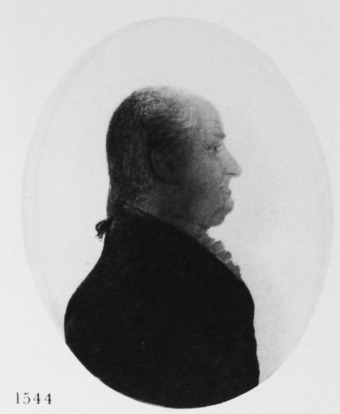
Unknown man
Profile painted on glass in line against a stippled base
2 December 1799
3 ¼ x 2 ½ in./83 x 64mm.
Frame: papier mâché, with pearwood surround and verre églomisé border
An incomplete inscription on the reverse reads, ‘ – ken on Monday/2nd od Decr. 1799/by Arth. L -.’
M. A. H. Christie collection
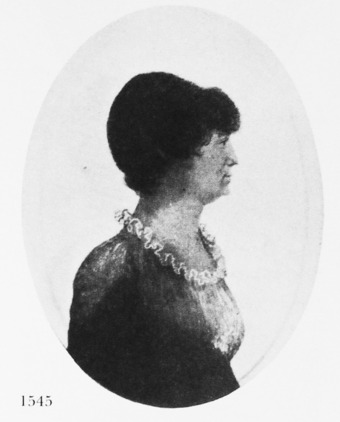
Unknown woman
Profile painted on glass in line against a stippled base
c. 1805-1808
3 ¼ x 2 ½ in./83 x 64mm.
Frame: papier mâché, with pearwood oval and verre églomisé border
M. A. H. Christie collection
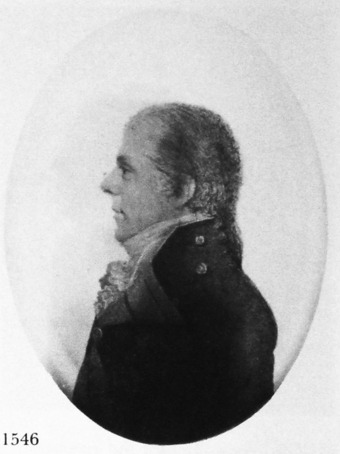
Unknown naval officer
Profile painted on glass in line against a stippled base
1808
3 ¼ x 2 ½ in./83 x 64mm.
Frame: papier mâché, with pearwood oval and verre églomisé border
Signed on blue paper on the reverse, ‘By Lea, Portsmouth, 1808.’
M. A. H. Christie collection

Major Lewis
Profile painted on glass in line against a stippled base
c. 1810
3 ¼ x 2 ½ in./83 x 64mm.
Frame: papier mâché, with pearwood surround and verre églomisé border
Mrs Peggy Hickman collection

Unknown man
Profile painted on glass in line against a stippled base
c. 1810
3 ¼ x 2 ½ in./83 x 64mm.
Frame: papier mâché, with pearwood oval and verre églomisé border
M. A. H. Christie collection

Unknown man, probably a naval officer
Profile painted on glass in line against a stippled base
c. 1810-14
3 ¼ x 2 ½ in./83 x 64mm.
Frame: papier mâché, with pearwood oval and verre églomisé border
Mrs Peggy Hickman collection
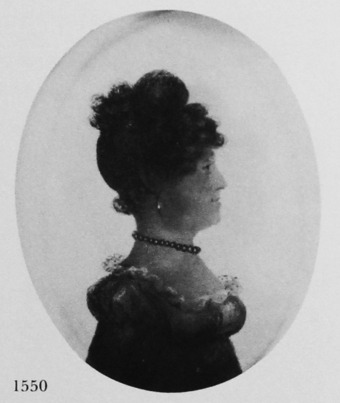
Unknown woman
Profile painted on glass in line against a stippled base
c. 1814-16
3 ¼ x 2 ½ in./83 x 64mm.
Frame: papier mâché, with pearwood oval and verre églomisé border
M. A. H. Christie collection

Unknown woman
Profile painted on glass in line against a stippled base
c. 1818
3 ¼ x 2 ½ in./83 x 64mm.
Frame: papier mâché, with pearwood oval and verre églomisé border
Crown Copyright. Victoria and Albert Museum, No. P146. 1922

Inscription of Arthur Lea.
M. A. H. Christie collection
Detail

Face and hair of a woman. Detail from a profile by Lea, showing stippling. (1550)
M. A. H. Christie collection
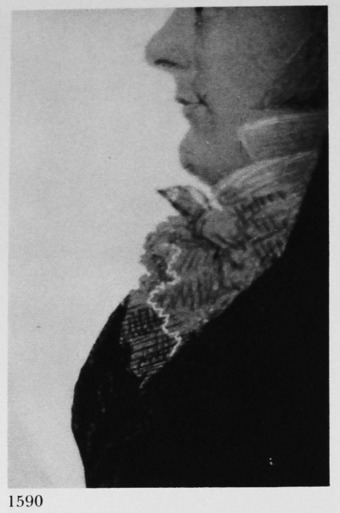
Face of a man and his shirt-frill. Detail from a profile by Lea, showing the artist’s brushwork and the strong white line of the shirt-frill. (1548)
M. A. H. Christie collection
